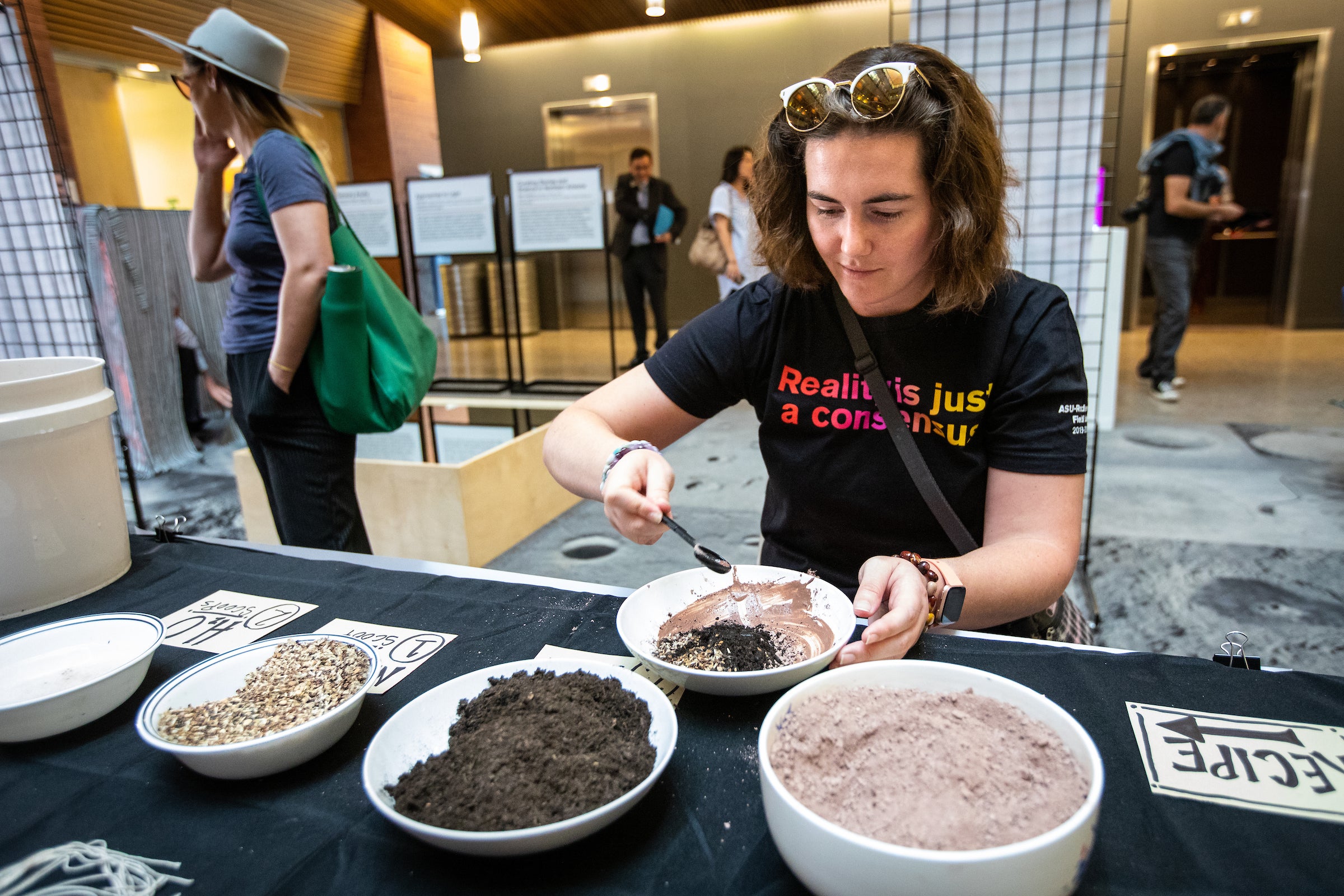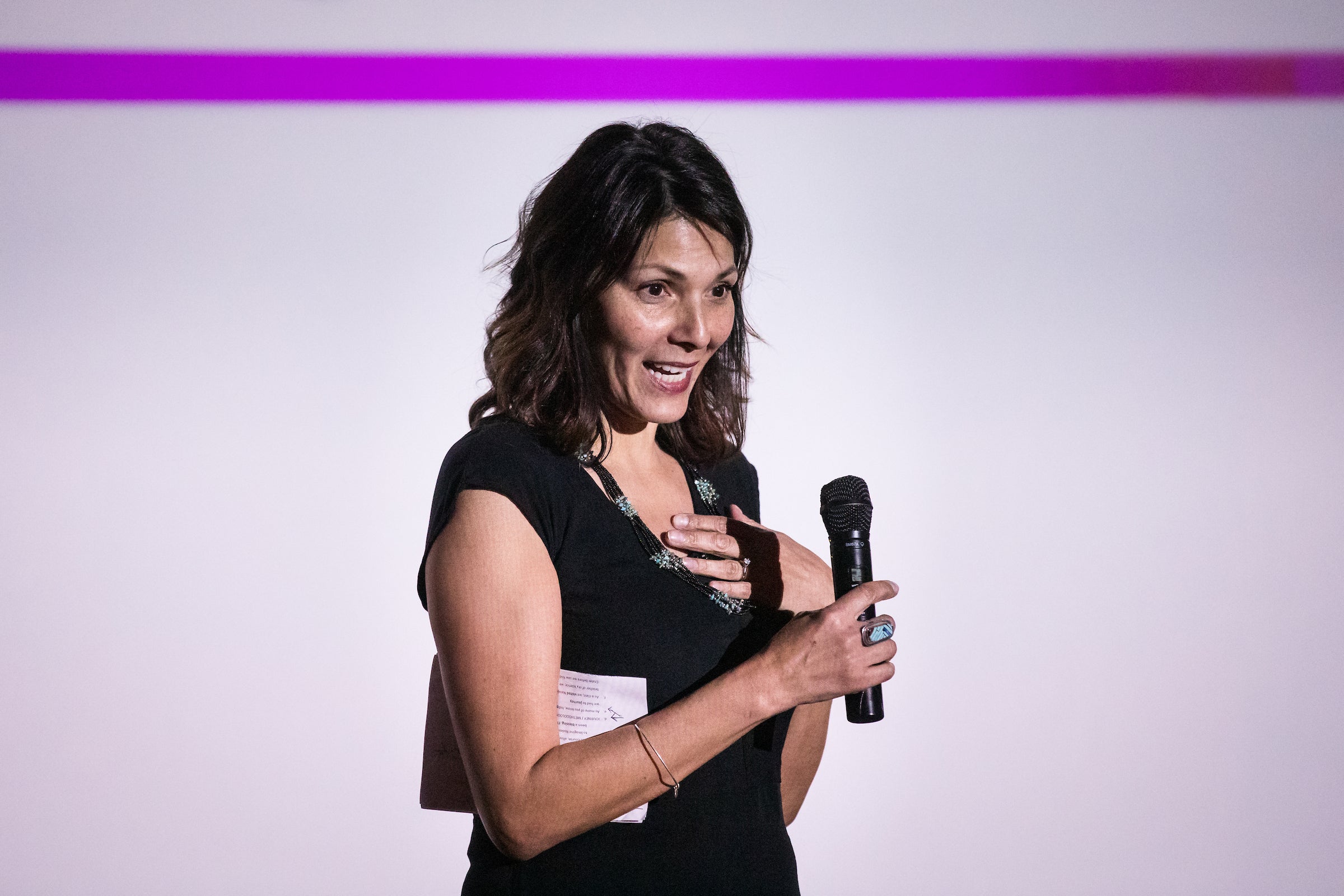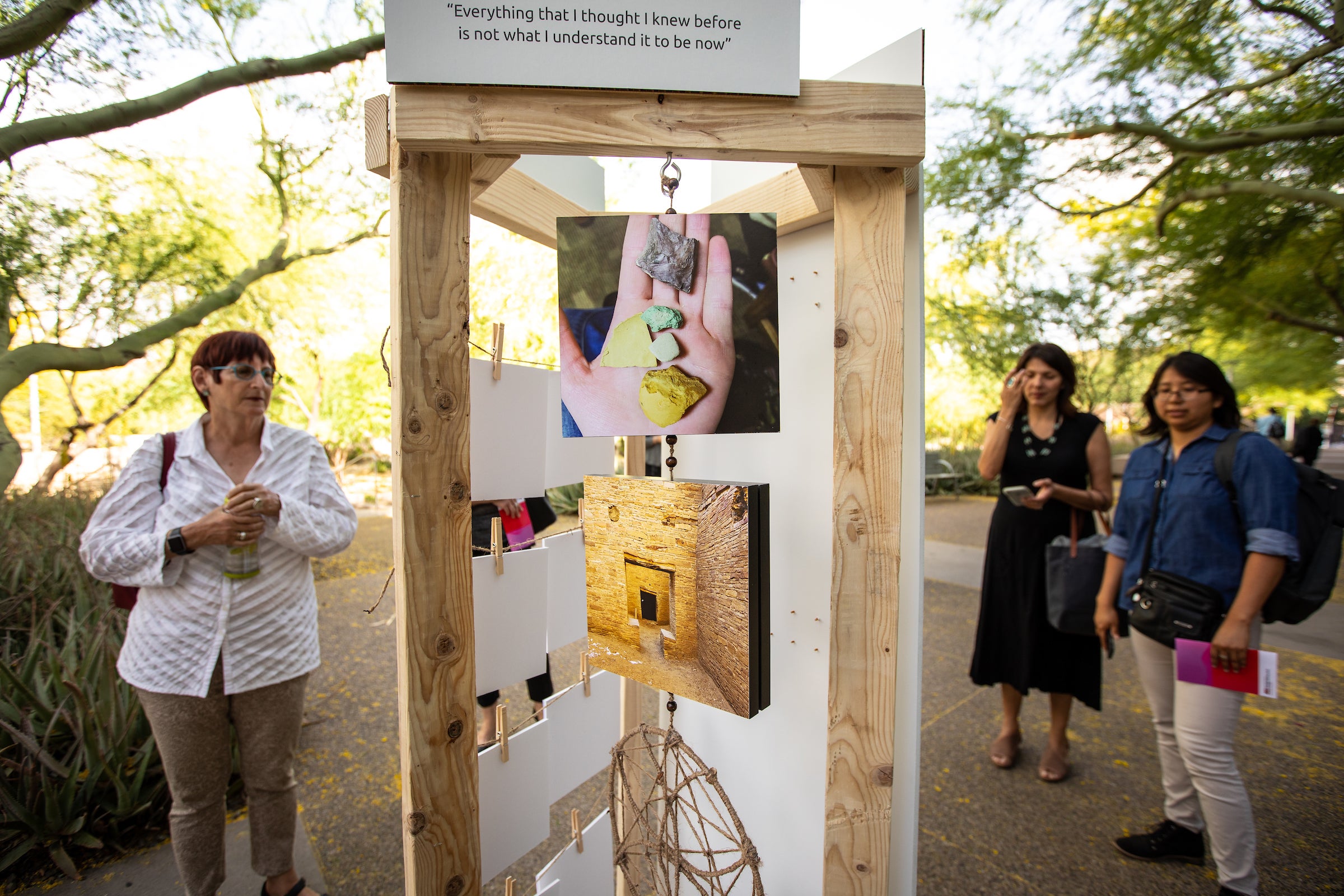Roden Crater, a large-scale art installation of light and perception in northern Arizona, is seen by only a few hundred people every year. This past year, 60 Arizona State University students were able to visit and study the artwork as part of a new collaboration with artist James Turrell.
Many of the students described the experience as transformative and overwhelming, and it inspired them to create an amazing array of art, which they displayed on Monday at the Tempe campus.
“My experience at the crater was tough to put into words, and that’s the constant struggle we’ve all been having,” said Celina Osuna, a graduate student in English.
“It was a shared group experience and yet so highly individualized.”
The students’ artwork included videos, sound installations, performance, photography, literature, paintings and textile art. Some wrote poetry about volcanic deities or imagined Star Trek episodes. One class got up at 4:30 a.m. during their visit to photograph dawn breaking near the crater.
Many of the showcase exhibits were interactive. Visitors could crawl into an inflatable dome and view a 360-degree film projected on the ceiling. The immersive film and sound experience explored Turrell’s art on the ASU campus as well as sites in Northern Arizona near Roden Crater.
Brandi Cooper, a graduate student in the School of Art, invited participants to make “seed bombs” out of mud, water and seeds to draw attention to the environmental impact of Roden Crater. Students in the “Indigenous Stories and Sky Science” course put up a black tent outside with Navajo constellations in the ceiling.
Digital culture senior Sophia Burgess creates a seed bomb with seeds from 19 native annuals and perennials that she'll toss in a special location during monsoon season. Photo by Charlie Leight/ASU Now
The five “field lab” classes included immersive coursework with visiting experts. Students studied sacred architecture and indigenous astronomy, learned about color from a theoretical astrophysicist and had a workshop on the sense of taste. One student built a sensory-deprivation chamber to better understand perception.
But the centerpiece of all five courses was the visit to Roden Crater, with the classes taking the trips at different times.
“I had been working on ideas of perception and studying James Turrell,” Osuna said. “I was reading the books, looking at the photos and seeing all the videos, and nothing can supplant the experience of being there.
“It shows the importance of place and scale and how that can affect so many of us from different disciplines.”
Eliza Weber, a Master of Fine Arts student in ceramics, created a 9-foot-by-9-foot installation on the sidewalk made entirely of wispy yellow palo verde blossoms called “At our feet, above our heads.” She visited Roden Crater in February with the “Art and Sensory Acuity” class.
“Turrell’s pieces are about experience and I’m an object maker,” she said.
“But an object felt strange to me for this. So for this, the process is the piece rather than the object, which is ephemeral.”
Roden Crater is a transdisciplinary fusion of art, engineering, astronomy and architecture that manipulates viewers’ perceptions. One installation is a 900-foot-long tunnel that acts as a pinhole camera, which Weber found profoundly moving.
“The tunnel was almost a life-and-death phenomenon,” she said. “It’s this interesting way of walking toward the light where it’s, ‘Are you going to life or to death?’”
Professor Wanda Dalla Costa discusses her class, "Indigenous Stories and Sky Science," at the ASU-Roden Crater Field Labs Showcase in Marston Exploration Theater in ISTB 4 on April 29. Photo by Charlie Leight/ASU Now
Wanda Dalla Costa taught the “Indigenous Stories and Sky Science” course and took her class on a five-day trip to visit indigenous sites in northern Arizona, New Mexico and Colorado. Dalla Costa, an architect, is Institute Professor in The Design School, associate professor in the School of Construction and a member of the Saddle Lake First Nation in Alberta, Canada.
“We took a journey before the crater to set up the contextual space,” she said. “This is a deep space and it has a lot of deep history. There were a lot of other subjects that we had to understand.”
The students visited ancient indigenous structures aligned to the solstice and Hopi petroglyphs.
“We had to study boundaries. What part of this story is ours to tell?” she said. “It was a much different experience for us by the time we arrived at the crater.”
Selina Martinez, who is pursuing a master’s degree in architecture and is a member of the Pascua Yaqui Tribe, was in Dalla Costa’s class.
“The biggest thing I learned is that there are so many other stories that exist there. There are other perspectives and the individual experience we got at the crater was amazing, but there was a collect experience we had as a group that gives you the community side,” she said.
Turrell attended the showcase and participated in a moderated discussion with Ed Krupp, an astronomer and the director of the Griffith Observatory in Los Angeles. The two men attended Pomona College together.
“I got into in psychology because in art classes if you took blue paint and yellow and mixed them you got green but if your took blue light and yellow light you got white light, which is a surprise. It was very important to understand the psychology of perception,” Turrell said.
Krupp said that both men were drawn to astronomy, which seeks to find meaning.
Environmental design junior Nicole Algien created a display of photographs taken while on a field trip in a class with Institute Professor Wanda Dalla Costa, a part of the ASU-Roden Crater Field Labs Showcase. Photo by Charlie Leight/ASU Now
“The facts lead to understanding of a greater picture of the cosmos, and that’s the purpose of doing astronomy. It’s not to create a stamp collection of what is out there but to understand how in the world all of this is working together,” he said.
ASU started the partnership with Turrell earlier this year. The collaboration will help complete Roden Crater, where Turrell has spent decades working on the installations. The enterprise seeks to raise $200 million to complete the project, which is about one-fifth done, and to build infrastructure at the site, including a visitors center.
ASU and the Skystone Foundation, a nonprofit that raises money and operates Roden Crater, are in the midst of a year-long planning process, funded by an anonymous gift of $2 million, to determine the scope of the project. The field labs were pilot courses as part of that planning process, which is being led by Steven Tepper, dean of the Herberger Institute for Design and the Arts.
“For us, we were thinking of Roden Crater as an extraordinary learning laboratory like none that has ever existed,” Tepper said at the showcase on Monday. “What would it look like to build a learning enterprise around a singular, masterful work of art and how could that drive generations of future learners and scholars to think and create in response to this?
“We want all of our classes to achieve that sense of wonder at the possibilities.”
Ed Finn, founding director of the Center for Science and the Imagination and an associate professor with a joint appointment in the School of Arts, Media and Engineering and the Department of English, taught the “Approaches to Light” course.
“Classes like this are why I came to ASU,” he said. “Light is so fundamental to our experience. Civilization is a story of our manipulation of light from fire all the way to lasers.
“The challenge for students was to figure out what to do with this overwhelming topic.”
Stephanie Gonzalez, a graduate student in the School of Art, said that Roden Crater made her question the notion of art.
“I came back and went into my studio and looked at my work. I wondered what I could do with my practice to reshape the question of what art can be.”
Top photo: Artist James Turrell (right) has a discussion with his Pomona College classmate Ed Krupp, long-time director of the Griffith Observatory, moderated by ASU Herberger Institute Dean Steven Tepper, at the ASU-Roden Crater Field Labs Showcase in Marston Exploration Theater in ISTB 4, Monday, April 29, 2019. Photo by Charlie Leight/ASU Now
More Arts, humanities and education

ASU alumna makes her way back to the ASU Gammage stage for '¡azúcar!'
As the Los Angeles-based CONTRA-TIEMPO dance group prepares for its upcoming production “¡azúcar!” at ASU Gammage, for one member of the dance group it is also a nostalgic return to her home.Born in…

ASU FIDM professor wins international award for fantastical, sustainable creation
The horror of an ailing Earth inspired an Arizona State University fashion professor to create a fantastical garment out of sustainable, re-used and found materials that won a prestigious…

ASU workshop trains educators, professionals from marginalized communities in disaster science
As devastating as hurricanes can be to anyone caught in their paths, they strike marginalized communities even harder.To address this issue, a fund named for a former Arizona State University…



